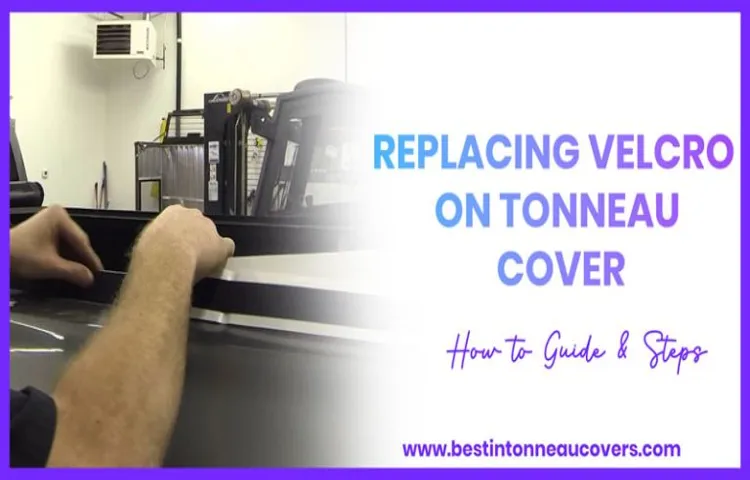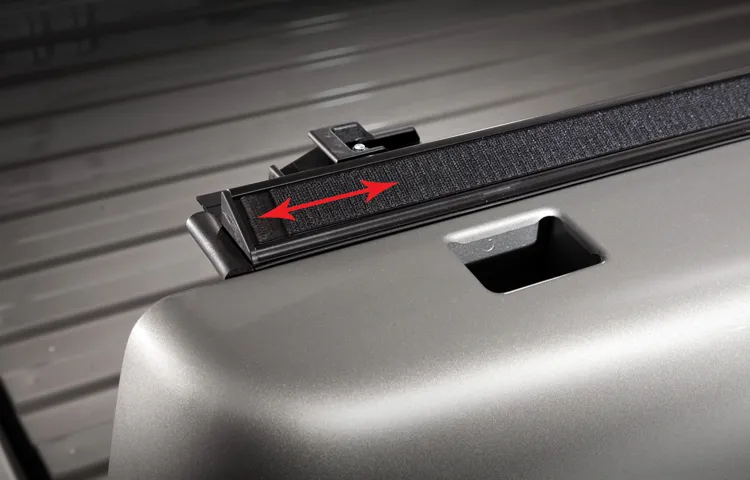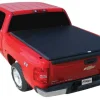So you’ve noticed that the velcro on your tonneau cover is starting to wear out. Maybe it’s become less sticky over time, or perhaps it’s completely torn and needs a replacement. Whatever the case may be, you’re now faced with the task of figuring out how to replace the velcro on your tonneau cover.
But don’t worry, I’m here to help! In this blog post, I’ll guide you through the process of replacing the velcro on your tonneau cover, step by step. By the end of this post, you’ll have all the information you need to tackle this DIY project and have your tonneau cover functioning like new again. So let’s dive in and get started!
Table of Contents
Introduction
If you have a tonneau cover for your truck that uses Velcro closures, you may eventually find that the Velcro becomes worn out or loses its effectiveness. But don’t worry – replacing the Velcro on your tonneau cover is actually a simple and straightforward process! All you need to do is purchase replacement Velcro strips, which are readily available at most hardware stores or online. Once you have your replacement Velcro, remove the old Velcro from the tonneau cover by carefully peeling it off.
Make sure to remove any adhesive residue as well. Then, measure and cut the replacement Velcro strips to fit the width of your tonneau cover, ensuring they are long enough to provide a secure closure. Finally, use a strong adhesive, such as a heavy-duty fabric glue or industrial strength Velcro adhesive, to attach the replacement strips to the tonneau cover.
Press firmly to ensure a tight bond, and allow the adhesive to dry completely before using your tonneau cover. With just a few simple steps, you can have your tonneau cover looking and functioning like new again!
Understanding the Velcro on Tonneau Covers
velcro on tonneau covers The velcro on tonneau covers is a key feature that provides a secure and weatherproof seal for your truck bed. Tonneau covers are designed to protect your cargo from rain, snow, and other elements, and the velcro plays an important role in ensuring a tight fit. It acts as a fastening mechanism that attaches the cover to the side rails of your truck bed, keeping it in place and preventing any unwanted movement.
The velcro strips are made of strong and durable materials that are designed to withstand the rigors of daily use. They are also easy to use, allowing you to quickly and effortlessly secure your tonneau cover in place. Whether you’re hauling groceries, tools, or camping gear, the velcro on tonneau covers provides a reliable and convenient way to keep your cargo safe and protected.

Importance of Replacing Velcro
Velcro, a hook-and-loop fastener, has become a part of our daily lives, serving as a convenient and simple way to secure items together. However, over time, the Velcro can lose its effectiveness due to wear and tear. This is where the importance of replacing Velcro comes into play.
By replacing the worn-out Velcro, we can ensure that our items are securely fastened and avoid any mishaps or accidents. Furthermore, replacing Velcro can also improve the overall aesthetic appeal of our belongings, as worn-out Velcro can look shabby and unattractive. So, let’s explore why it’s important to replace Velcro and how it can benefit us in the long run.
Preparation
If your tonneau cover’s velcro is worn out or no longer sticking properly, don’t worry – it’s something you can easily replace yourself. Before getting started, make sure you have the right tools and materials, such as a replacement velcro strip, a ruler or measuring tape, scissors, and a strong adhesive. First, measure the length of the area where the velcro needs to be applied.
Cut the replacement strip to this length, ensuring it is the same width as the old velcro. Next, peel off the backing of the adhesive side of the replacement velcro and carefully apply it to the tonneau cover, making sure it is aligned correctly. Press down firmly along the entire length of the strip to ensure proper adhesion.
Give it some time to dry and set, and then test it out to make sure it securely fastens. With just a little bit of preparation and some simple steps, you’ll have your tonneau cover looking and functioning like new again.
Gathering the Necessary Tools and Materials
preparation, tools and materials, DIY project In order to successfully tackle a DIY project, it is crucial to gather all the necessary tools and materials beforehand. This preparation step will save you time and frustration later on. So, what exactly do you need to do to get ready? First, make a list of all the tools and materials you will need for your project.
This will ensure that you don’t forget anything when you head to the store. Once you have your list, check your toolbox to see if you already have any of the required tools. If not, it’s time to hit the hardware store.
While you’re there, take your list and gather all the materials you’ll need as well. This might include paint, screws, nails, or any other supplies necessary for your project. By being prepared and gathering all the tools and materials you need, you’ll be setting yourself up for success right from the start.
So grab your list and let’s go shopping!
Removing the Old Velcro
One important step in preparing to remove old Velcro is to gather all the necessary tools and materials. This includes a pair of scissors or a seam ripper, a small brush or toothbrush, and a cleaning solution. The scissors or seam ripper will be used to carefully cut or remove the old Velcro from the surface it is attached to.
The small brush or toothbrush can help remove any debris or dirt that may have accumulated over time. Lastly, a cleaning solution can be used to ensure that the surface is thoroughly cleaned before applying new Velcro. By taking the time to gather these materials, you can ensure that the removal process goes smoothly and efficiently.
So, go ahead and gather your materials, because we’re about to dive into the world of removing old Velcro!
Cleaning the Surface
cleaning the surface
Replacing the Velcro
If you’ve noticed that the velcro on your tonneau cover has seen better days, don’t worry – replacing it is easier than you might think! Velcro is a commonly used fastener on tonneau covers, helping to secure them in place and keep your truck bed protected. Over time, however, the velcro can become worn out or lose its adhesive properties, making it less effective. To replace the velcro on your tonneau cover, start by removing the old velcro strips from both the cover and the truck bed.
Next, clean the surface thoroughly to remove any dirt or residue. Measure and cut new velcro strips to fit the length of the cover and bed, then apply them firmly in place, making sure to line up the hooks and loops correctly. Press down firmly to ensure a strong bond.
Once the new velcro is secure, test it out by closing and opening the tonneau cover to make sure it fastens properly. With new velcro in place, your tonneau cover will be as good as new, keeping your truck bed protected and secure.
Choosing the Right Velcro
Replacing the Velcro on your items can be a simple and cost-effective solution to extending their lifespan. But with so many options and variations of Velcro available, it can be overwhelming to choose the right one for your needs. The first step in replacing Velcro is to determine the purpose of your item.
Do you need a strong adhesive that can securely hold heavy objects, or are you looking for something more flexible and easy to open and close? Once you have identified your needs, you can then consider the different types of Velcro available. There are hook and loop fasteners, which are the most common, as well as adhesive-backed Velcro for easy installation. Additionally, there are heavy-duty options for industrial use, and even specialized Velcro for delicate fabrics.
Taking the time to research and choose the right Velcro for your item will ensure a successful replacement that will last for years to come.
Cutting and Measuring the Velcro Strips
Cutting and Measuring the Velcro Strips Now that you’ve removed the old Velcro strips, it’s time to replace them with fresh ones. But before you dive in, you’ll need to know how to properly cut and measure the Velcro strips for a perfect fit. First, take a moment to assess the size of your item and determine how much Velcro you will need.
Grab a measuring tape and measure the length and width of the area where you will be attaching the Velcro. This will give you the dimensions you need to work with. Once you have your measurements, it’s time to cut the Velcro strips.
Use a pair of sharp scissors or a utility knife to slice through the Velcro. Remember to cut on a hard surface to ensure a clean and straight cut. It’s also a good idea to use a ruler or straight edge to guide your cuts.
Be mindful of the size of the Velcro strips you need and cut them accordingly. Replacing the Velcro Now that you have your Velcro strips cut to size, it’s time to replace the old ones. Start by peeling off the adhesive backing of one side of the Velcro strip.
Carefully place it onto the designated area, aligning it with your measurements. Press down firmly to ensure a secure bond. Repeat this process for the other side of the Velcro, making sure to align it properly with the first strip.
Take a moment to ensure that both sides of the Velcro are securely attached and that they align perfectly. This will ensure that your item can be fastened securely once the Velcro is in place. Finally, give the Velcro strips a good press to ensure they adhere well.
Applying the Velcro to the Tonneau Cover
velcro, tonneau cover, replacing, applying, burstiness
Finishing Touches
If your tonneau cover’s velcro is wearing out or coming loose, it’s time to replace it. Don’t worry, it’s a simple DIY project that you can easily tackle at home. Start by obtaining a replacement velcro strip that matches the size and style of your cover’s existing velcro.
Once you have the new velcro, remove the old strip by carefully peeling it off. Then, clean any residue or adhesive from the tonneau cover to ensure a smooth surface for the new velcro. Next, measure and cut the replacement velcro strip to the appropriate length, making sure it aligns with the corresponding strip on the tonneau cover.
Finally, carefully apply the new velcro strip to the cover, pressing it firmly into place. Congratulations, you have just given your tonneau cover a fresh set of velcro and ensured it will securely fasten for many more miles on the road.
Testing the Velcro
Velcro is a popular fastening material that is widely used in various industries and applications. It is known for its strong adhesive properties and ease of use. However, before it can be used in the final product, it needs to undergo thorough testing to ensure its quality and durability.
This step is vital to ensure that the Velcro will not fail or lose its adhesive power over time. During the testing phase, various factors such as the strength of the adhesive, the durability of the hook and loop system, and the resistance to wear and tear are assessed. Additionally, the Velcro is tested under different conditions to simulate real-world usage and check its performance.
This includes tests for temperature resistance, moisture resistance, and chemical resistance. By conducting these tests, manufacturers can guarantee that the Velcro will meet the highest standards of quality and reliability. These finishing touches are crucial as they ensure that the Velcro is ready to be used in a wide range of applications, from clothing and shoes to automotive and aerospace industries.
Securing the Velcro
Once you’ve got your Velcro straps securely fastened, it’s time to add those finishing touches to ensure that everything is locked down tight. One way to do this is by applying a little extra security to the Velcro itself. This can be done by using a double-sided adhesive tape to hold the Velcro in place.
The tape will act as an extra layer of security, preventing the Velcro from accidentally coming undone. Another option is to sew a few stitches through the Velcro and the fabric it is attached to. This will create a stronger bond and further reinforce the Velcro’s hold.
By taking these extra steps, you can have peace of mind knowing that your Velcro straps will stay in place no matter what. So go ahead and secure that Velcro!
Conclusion
And there you have it, a simple and straightforward guide on how to replace Velcro on your tonneau cover. By following these steps, you can say goodbye to your worn-out Velcro strips and hello to a secure and functional cover once again. Now, some might say that replacing Velcro on a tonneau cover is as easy as pie, but we think it’s even easier – it’s as easy as eating the last slice of pie without getting caught.
Just like you can stealthily enjoy that tasty treat, you can now stealthily replace your Velcro and impress all your friends with your handy skills. So, whether you’re a seasoned DIY enthusiast or a beginner in the world of repairs, don’t fear the task of replacing Velcro on your tonneau cover. With a little patience and our handy guide, you’ll have your cover looking and functioning like new in no time.
Remember, a well-maintained tonneau cover not only keeps your truck bed protected but also adds a touch of style to your vehicle. So, don’t let worn-out Velcro strip away your pride in your ride – take action and replace it today! Now go forth, fearless DIY-er, and conquer the Velcro replacement challenge. And remember, if at any point you feel overwhelmed, just take a deep breath and imagine yourself as the superhero of tonneau covers – the Velcro Avenger.
Because with the power of Velcro-replacement knowledge on your side, you truly are unstoppable.”
Maintaining the Velcro for Longevity
Velcro is a highly convenient and versatile fastening solution that can be found in many aspects of our daily lives. From shoes to bags to clothing, Velcro provides a simple and efficient way to secure and adjust items. However, in order to maintain the longevity of Velcro, it is important to pay attention to the finishing touches.
This means taking care of the Velcro to ensure that it continues to function properly for years to come. One way to do this is by regularly cleaning the Velcro. Over time, dirt and debris can become trapped in the hooks and loops of the Velcro, which can prevent it from properly adhering and securing items.
Using a soft brush or a toothbrush, gently clean the Velcro to remove any dirt or debris. Another important step is to avoid exposing the Velcro to excessive heat. High temperatures can cause the Velcro to melt or warp, which can significantly reduce its effectiveness.
Therefore, it is important to keep Velcro away from sources of heat such as radiators or direct sunlight. By following these simple steps, you can ensure that your Velcro stays in top condition and continues to provide the convenience and functionality that it is known for.
Enjoying a Secure Tonneau Cover
tonneau cover, truck bed cover
FAQs
How do I replace the Velcro on my tonneau cover?
To replace the Velcro on your tonneau cover, first, remove the old Velcro strips. Then, measure and cut the new Velcro strips to the appropriate length. Finally, apply the adhesive side of the new Velcro strips to the tonneau cover and press firmly to secure.
Can I replace just one side of the Velcro on my tonneau cover?
Yes, you can replace just one side of the Velcro on your tonneau cover. However, it is recommended to replace both sides to ensure proper functionality and a secure fit.
What tools do I need to replace the Velcro on my tonneau cover?
The tools you may need to replace the Velcro on your tonneau cover may include a utility knife or scissors to remove the old Velcro strips, a measuring tape to measure the length of the new Velcro strips, and possibly a heat gun or hairdryer to assist in removing any adhesive residue.
Where can I purchase replacement Velcro for my tonneau cover?
You can purchase replacement Velcro for your tonneau cover from various automotive and hardware stores. Additionally, you may also find online retailers that specialize in tonneau cover accessories.
How often should I replace the Velcro on my tonneau cover?
The frequency of Velcro replacement on your tonneau cover may depend on factors such as usage, exposure to weather elements, and overall wear and tear. It is recommended to inspect the Velcro regularly and replace it as needed to ensure proper functioning.
Can I repair the Velcro on my tonneau cover instead of replacing it?
In some cases, minor repairs can be made to the Velcro on your tonneau cover, such as re-stitching loose threads or applying adhesive to secure loose sections. However, if the Velcro is severely damaged or worn out, it is best to replace it for optimal performance.
Are there any maintenance tips to prolong the life of the Velcro on my tonneau cover?
To prolong the life of the Velcro on your tonneau cover, it is recommended to periodically clean it using a mild soap and water solution. Additionally, avoid exposing the Velcro to excessive heat, direct sunlight, or harsh chemicals as these can deteriorate its adhesive properties.



